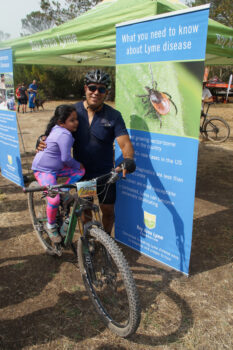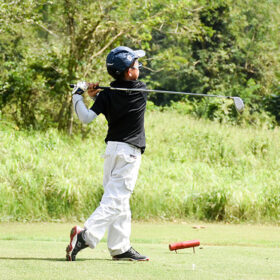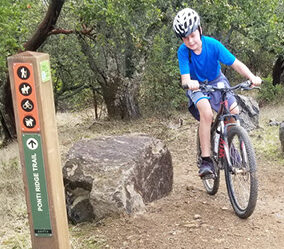 Outdoor adventures and activities can put you and your family at risk for tick-borne diseases. Understand how to protect yourself and know the symptoms of Lyme, especially if you or your family members engage in high-risk sports activities.
Outdoor adventures and activities can put you and your family at risk for tick-borne diseases. Understand how to protect yourself and know the symptoms of Lyme, especially if you or your family members engage in high-risk sports activities.
Since our founding, Bay Area Lyme has supported a suite of prevention programs to build awareness in communities nationwide. Knowing information about tick-borne infections is the best way to prevent the disease.
The following sports are particularly at high risk for tick bites and tick-borne disease. As part of our Lyme Awareness Program, we have sponsored golf, equestrian, trail running and mountain bike races in order to educate those sporting communities on ticks and tick-bite prevention.
Prevent Tick Bites
- Wear light-colored clothes to make it easier to see tiny ticks
- Spray golf shoes, socks and bag with permethrin tick repellent
- Use tick repellent such as lemon eucalyptus oil, nootkatone or DEET
- Walk in the center of the path; avoid sitting in high grasses or on fallen logs
- At home, put golf clothes in a hot dryer for 10 minutes to kill ticks
- Tick check yourself, jackets, golf bag, and other gear
- Shower to wash away hard to spot ticks that have not yet latched on
- Check carefully and use a magnifying glass or smartphone magnifier
- Redo tick checks 3 days after each golf outing to see if you missed any ticks
Early-stage Lyme Symptoms
Early detection and treatment are crucial, and symptoms vary between people.
- Skin rash (commonly, but not always, a circular or bullseye rash around the bite area)
- Headaches or stiff neck
- Flu-like ailments, fever or chills
- Muscle and joint pain
- Fatigue or lack of energy
- Swollen lymph nodes/stiff neck
Advanced-stage Lyme Symptoms
If not treated promptly, Lyme may progress to a disabling condition.
- Arthritis
- Severe headaches or migraines
- Stiff neck due to swollen tissues
- Chronic fatigue
- Problems with mood or sleep
- Numbness and/or tingling in hands, feet, or back
- Problems with memory, hearing, and vision
- Inflammation of the heart, brain
 Equestrians
Equestrians
-
Horses are a big target for questing ticks
-
Ticks can easily transfer from horse to rider
-
Back-country and trail riding especially exposes you and your horse to ticks
-
Lyme disease cannot be transmitted from horse to rider
For more information on symptoms of Lyme in horses visit Cornell University College of Veterinary Medicine
Golfers
-
 Golfers are at high risk of Lyme disease
Golfers are at high risk of Lyme disease -
Nearly 25% of golfers have been diagnosed with Lyme disease*
-
Fairways and roughs offer the ideal environment for ticks
-
Link to study showing “nearly 25% of golfers have been diagnosed with Lyme disease”
Mountain Bikers
-
 Biking grassy and/or wooded trails exposes you to ticks and tick bites
Biking grassy and/or wooded trails exposes you to ticks and tick bites -
Overgrown narrow trails should be avoided
-
Tips for mountain bikers and cyclists can be found here.
Trail Runners & Hikers
-
Hiking or running grassy and wooded trails exposes you to ticks
-
Overgrown, narrow trails should be avoided
-
Tips for trail runners and hikers can be found here.
General prevention can be found here.
What to do if you find a tick.
Awareness Related Publications Published Under Initiative to Date:
